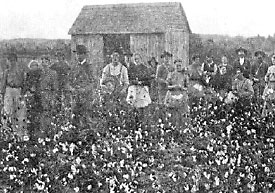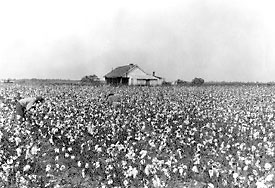North
Carolina
Business
History
Cotton was a small-time crop prior to 1793, due to the labor intensive requirement to separate cotton seeds from the cotton. For example, in the 18th Century, 25 farm hands working on 25 cotton bales often took 100 days to seed the crop.




As Moses Brown, who funded and owned the first powered spinning (Arkwright system of machinery) mill with Samuel Slater in 1791 in Rhode Island, said about Southern cotton: "The unripe, short, and dusty part being so enveloped with that which would be good, if separated properly at first, so spoils the whole as to discourage the use of it in the machines."
But the Eli Whitney Cotton Gin, invented in 1793, did the work of ten men. As the gin was improved and access spread, it encouraged North Carolina farmers to grow the crop, which could be easily sold. Crop was hauled overland or on river boats to access points (Fayetteville, Columbia, Charleston, Cheraw, etc.) to ship north to powered textile spinning mills.
Beginning about 1840, cotton became a leading cash crop for North Carolina farmers.
The lure of being near the fields caused many to think about creating a powered textile mill. (See textiles). But the demand for cotton, focused farmers primarily on growing the crop in the South until 1840, when the effort to create new planting areas slowed. This allowed more resources to be diverted to cotton processing. Plus, pioneering efforts proved that cotton mills could be highly profitable.

The first mill in North Carolina was established around 1815 near Lincolnton and operated until 1819. It was replaced by another Lincolnton area mill in 1819 which operated under different owners until 1863. Textile mills proliferated during the 1840s in Alamance and other Piedmont areas, reaching 45 mills operating by 1860.
Cotton farming increased until the Civil War. The North Carolina cotton crop began to grow between 1860 with 145,514 bales and 1870 with 203,000 bales (480-lb. equivalent bales). Cotton production continued its steady increase until the 1920s,

By 1880, North Carolina was growing 446,000 bales annually, placing the state in 8th place, behind Mississippi, Georgia, Texas, Alabama, Arkansas, South Carolina, and Louisiana. But the price of cotton continued to remain low in the post-war era, creating massive hardships on farmers.
By 1900, North Carolina was producing 497,000 bales, which accelerated in the early 1900s to match the explosive growth of the textile industry. By 1925, North Carolina was producing 1,102,000 bales of cotton.
The Great Depression in the 1930s and the boll weevil began a downward trend in growing cotton until by 1980, the crop output was equivalent to the 1840s. But pressure on tobacco, insect-resistant cotton crop and a jump in cotton prices caused a renaissance in cotton planting in the state in the 1990s.
NC Cotton Crop*
(equivalent 480 lb
bales)
1810 3,296 bales
est.
1820 8,172 bales
est.
1830 17,571 bales est.
1840 34,617 bales
1850 73,845 bales
1860 145,514 bales
1870 203,000 bales
1880 446,000 bales
1890 509,000 bales
1900 497,000 bales
1910 735,000 bales
1920 961,000 bales
1930 803,000 bales
1940 770,000 bales
1950 181,000 bales
1960 231,000 bales
1970 155,000 bales
1980 52,000 bales
1990 263,000 bales
2000 1,429,000 bales
*source: 1870 - present are from the NC Agriculture
Department; statistics prior to 1840 are unreliable; our
estimates are statistical projections
derived from U.S. cotton
crop figures.
Note: cotton bales did not
reach the standard 480 lb
rate until 1880s-1940s.
Therefore, these equivalent
480 lb bales do not reflect the
actual number of bales made.
For example, in 1810, the
average bale weighted 228 lbs.;
1820 - 297 lbs.; 1830 - 341
lbs.; 1840 - 394 lbs.; 1850 -
414 lbs; 1860 - 477 lbs.
Cotton Prices
(upland, per lb.)
1810 18.9 cents
1820 16.8 cents
1830 12.2 cents
1840 10.7 cents
1850 16.1 cents
1860 12.4 cents
1864 141.9 cents
1870 18.2 cents
1880 14.1 cents
1890 11.1 cents
1900 12.0 cents
1910 14.1 cents
1920 14.8 cents
1930 9.6 cents
1940 9.9 cents
1950 41.0 cents
1960 33.3 cents
1970 22.5 cents
1980 79.5 cents
1990 69.0 cents
2000 53.0 cents
Industries
Laureates Contact
Us Home
2002-2007 Copyright. CommunicationSolutions/ISI
for web site and content.